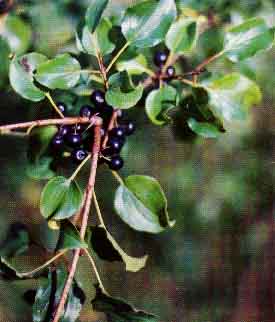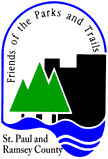
Common buckthorn, glossy (columnar), and fernleaf buckthorn are now on the noxious weed list in Minnesota. What this means is that they will no longer be sold and cannot be transported in Minnesota.
1 – KNOW YOUR BUCKTHORN!
Review the picture on the first page and if you still are not sure, cut a small branch that has leaves (and berries if present) and bring it to a professional nursery for identification.
2 – REMOVING SEEDLINGS AND SMALLER SHRUBS
Small seedlings can be removed by hand or by using a hoe. For larger shrubs up to 2.5″ in diameter, a Weed Wrench is available from Ace Rental at 1668 1/2 Grand Ave. (651-690-3510). It’s free to use and no chemical treatment is necessary!
3 – CUT LARGE SHRUBS AND TREAT THE STUMP
For buckthorn shrubs greater than two and one half inches, use a hand saw and cut as close to the ground as possible. Follow either option 1 or option 2 for the remaining stump:
- Environmentally safe method: dig the stump out (no chemicals are needed).
- Herbicide (8% Triclopyr, such as Brush-B-Gon) Method: For safety, it is extremely important to read and carefully follow the label directions. The herbicide stump treatment is most successful when used from July through October. PLEASE NOTE: Do not cut the shrub if rain is predicted within 4 hours.
- Purchase a hand spray bottle and use it exclusively for this herbicide. Wear disposable gloves and protective eyewear.
- Properly mark the spray bottle before pouring in the herbicide. DO NOT DILUTE!
- Immediately after cutting the shrub, spray only the remaining stump and exposed bark.
- After using the herbicide, pour it back in the original container for safe storage. Keep out of the reach of children.
4 – DISPOSAL OF BRANCHES
For most homeowners there are two options for brush disposal: drop off, or pick-up. NRG Processing Solutions at 915 N. Albert St. is open from April-November and will dispose of the brush for a minimal fee when you drop it off. For hours of operation, call 952-946-6999. Contact your garbage hauler about brush pick-up at your home. While burning is the best way of destroying seeds, it is not allowed in St. Paul. If you don’t live in St. Paul, call the city in which you live to inquire about burning permits.
5 – EDUCATION
Spread the message about buckthorn! Buckthorn is easily controlled in mowed areas, but in natural areas it is devastating. Often, people may not know that buckthorn is a problem. Education is the first step in understanding the destructive nature of this exotic shrub.
6 – WILL BUCKTHORN COME BACK?
If you carefully follow the steps listed under number three; your success rate will be reasonably high. Buckthorn only resprouts from the stump, not the roots. However, because each berry contains 3 or 4 seeds, seedlings may appear. Be diligent about pulling them!
7 – REPLANTING
About two weeks after chemically treating the buckthorn stump, you can replant a native shrub in the area. There are several shrub selections suitable for many planting conditions. With careful selection, you will have a wonderful non-invasive shrub, which will provide a wonderful habitat and possibly a food source for our feathered friends!
DISCLAIMER: The purpose of these instructions is to provide information. No product endorsement is intended or implied by the City of Saint Paul, Ramsey County or Friends of the Parks and Trails of St. Paul and Ramsey County. Carefully read all manufacturer’s directions prior to using any herbicide. Always use proper equipment and use extreme caution when applying a herbicide. Discard unused herbicide at a hazardous waste collection facility (call 651-773-4444 for information) or store it safely.
